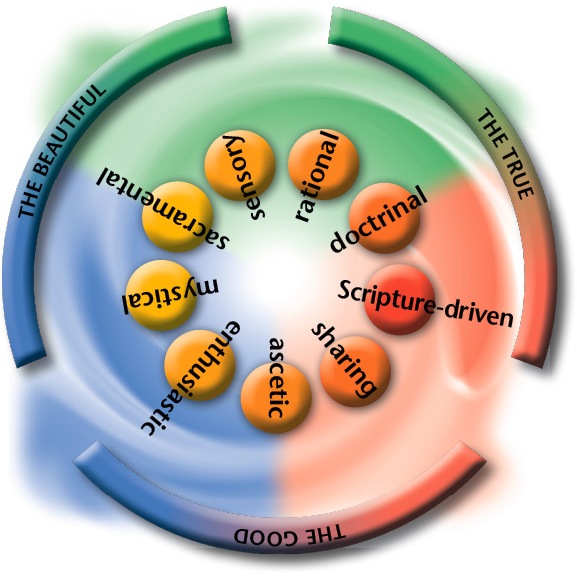What fascinates me about my Scripture-driven mentor Ian
I
have a downright allergy for a certain approach to the Bible—the approach where you take a specific concept (e.g. the minimum factor or the Trinitarian Compass), and consult a concordance under M like “minimum factor” or C like “compass” or T like “trinitarian” to check for biblical references. And the more references you find, the more “biblical” the concept! In contrast to other Scripture-driven people, Ian seems to share this same aversion. His concern is sober hermeneutics, the exposure of biblical principles that are then applied to life. In the development phase of our NCD tools he has repeatedly offered biblical insights which have challenged my own thinking. Whenever I get an e-mail with a “biblical thought” from Ian, I think, “Christian, you should take this very seriously. This could be, yet again, God‘s message for you, communicated through Scripture”—and delivered by Ian, my mentor for the Scripture-driven style.
 Graphical representation of the Scripture-driven style: It is essential to understand the positioning of this style within the Trinitarian Compass. Christians with a Scripture-driven style should take into special consideration the two opposite styles (mystical and sacramental) as these throw light on the dark side of the Scripture-driven style.
Graphical representation of the Scripture-driven style: It is essential to understand the positioning of this style within the Trinitarian Compass. Christians with a Scripture-driven style should take into special consideration the two opposite styles (mystical and sacramental) as these throw light on the dark side of the Scripture-driven style.
On the one hand, the Scripture-driven style belongs to the red style family; on the other hand, to the dogmatic style family. Depending on its leaning toward one of its two neighbor styles, it can manifest itself in a more doctrinal or sharing variety. For Christians with a Scripture-driven style, it is most natural to express their spirituality through the study and proclamation of the Word of God. The strength of this style is the application of biblical principles to everyday life; the peril is to appeal to Scripture in areas where it doesn‘t offer any teaching (biblicism).
 Christians with a Scripture-driven style feel closest to God when they are directly dealing with the Bible. All of their experiences are perceived through the filter of their biblical understanding.
Christians with a Scripture-driven style feel closest to God when they are directly dealing with the Bible. All of their experiences are perceived through the filter of their biblical understanding.
To those approaching the Scripture-driven style from the opposite side
 If you have the mystical or the sacramental style, there is no doubt that the Word of God plays an important role in your life. Even if you have heard representatives of the red styles say that you have virtually disregarded the Word of God, you know that this isn‘t true. In your style, Scripture also plays an important, even essential role. However, in your daily life it plays a different role than it does for representatives of the Scripture-driven style.
If you have the mystical or the sacramental style, there is no doubt that the Word of God plays an important role in your life. Even if you have heard representatives of the red styles say that you have virtually disregarded the Word of God, you know that this isn‘t true. In your style, Scripture also plays an important, even essential role. However, in your daily life it plays a different role than it does for representatives of the Scripture-driven style.
As we have seen, the Scripture-driven style takes the subjective aspect of our approach to the Bible very seriously. However, within the aesthetic style family (the category that mystical and sacramental styles are part of), this subjectivity plays a far greater role. This can—especially in the case of the mystical style—go so far that Scripture is really negated as normative authority. Take a look back into church history: Have there been “mystics” who have succumbed to this danger? Yes, there have been, and more than a few. Has everyone with a mystical approach to God succumbed to this danger? Of course not. However, when thinking about the dangers of the mystical style, we should look out for this. The focus on “inwardness,” the experience of “Christ in me,” the feeling of “unity with God” (all such typically mystical categories) can be so strong that the Scriptures, even if they may not be questioned on a theological level, are hardly given any significance on a psychological level.
In the case of the sacramental style, the perils are slightly different. Representatives of this style frequently prefer the public listening of the biblical Word, especially in the context of a worship service, or the concerted reading of Scripture passages, especially in the form of prayers (e.g. Psalms). That is a wonderful approach to the Word of God that can appeal to many people, but especially to those who display the sacramental style. Don‘t let anyone convince you that this is just “dead ritual.” You know very well that it is far more than that.
What, then, is your danger? Precisely that your own approach to the Bible is reduced to these public settings, while at home, in your daily decisions, you only rarely open your Bible to receive guidance from the Word of God. Maybe you believe that without a theologically trained expert you cannot really understand God‘s Word. Or you are simply lacking practical instruction on how to do it. If this is the case, you can learn a lot from representatives of the Scripture-driven style. You need not become like them, but they can provide you with the very prompts that will help you integrate the Word of God into your daily life with greater power..
Further topics in the above chapter of the full version of the book
Ian, my mentor for the Scripture-driven style - My own need to learn - A transformational homework - A dynamic understanding of Scripture - The focus on hermeneutics - The core of the Scripture-driven style: The Bible as a "living Word" - The two wings of the Scripture-driven style - The strengths of the Scripture-driven style - The perils of the Scripture-driven style

